Northern storm petrel
Northern storm petrels are seabirds in the family Hydrobatidae, part of the order Procellariiformes. The family was once lumped with the similar austral storm petrels in the combined storm petrels, but have been split, as they were not closely related. These smallest of seabirds feed on planktonic crustaceans and small fish picked from the surface, typically while hovering. Their flight is fluttering and sometimes bat-like.
| Northern storm petrels | |
|---|---|
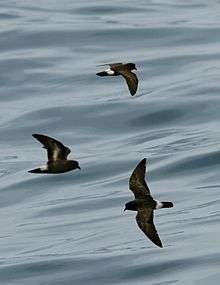 | |
| European storm petrels | |
| Scientific classification | |
| Kingdom: | Animalia |
| Phylum: | Chordata |
| Class: | Aves |
| Order: | Procellariiformes |
| Family: | Hydrobatidae Mathews, 1912 |
| Genera | |
The northern storm petrels are found in the Northern Hemisphere, although some species around the Equator dip into the south. They are strictly pelagic, coming to land only when breeding. In the case of most species, little is known of their behaviour and distribution at sea, where they can be hard to find and harder to identify. They are colonial nesters, displaying strong philopatry to their natal colonies and nesting sites. Most species nest in crevices or burrows, and all but one species attend the breeding colonies nocturnally. Pairs form long-term, monogamous bonds and share incubation and chick-feeding duties. Like many species of seabirds, nesting is highly protracted, with incubation taking up to 50 days and fledging another 70 days after that.
Several species of storm petrel are threatened by human activities. One species, the Guadalupe storm petrel, is thought to have gone extinct. The principal threats to storm petrels are introduced species, particularly mammals, in their breeding colonies; many storm petrels habitually nest on isolated mammal-free islands and are unable to cope with predators such as rats and feral cats.
Taxonomy
Two subfamilies, the Hydrobatinae and Oceanitinae, were recognized in the past within a single large family Hydrobatidae, but this has since been split with the elevation of the Oceanitidae to family status.[1] The Oceanitinae, or austral storm petrels, were mostly found in southern waters (though Wilson's storm petrel regularly migrates into the Northern Hemisphere); the seven species were in five genera. The Hydrobatinae, or northern storm petrels, were the two genera Hydrobates and Oceanodroma. They were largely restricted to the Northern Hemisphere, although a few visit or breed a short distance south of the equator. Cytochrome b DNA sequence analysis suggested that the family was paraphyletic and more accurately treated as two distinct families.[2] The same study found that the austral storm petrels are basal within the Procellariiformes. The first split was the family Oceanitidae, with the Hydrobatidae splitting from the rest of the order at a later date. A few fossil species have been found, with the earliest being from the Upper Miocene.[1]
Morphology and flight
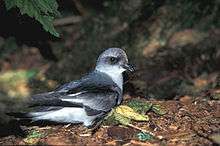
Northern storm petrels are the smallest of all the seabirds, ranging in size from 13–25 cm in length. The Hydrobatidae have longer wings than the austral storm petrels, forked or wedge-shaped tails, and shorter legs. The legs of all storm petrels are proportionally longer than those of other Procellariiformes, but they are very weak and unable to support the bird's weight for more than a few steps.[1]
All but two of the Hydrobatidae are mostly dark in colour with varying amounts of white on the rump. Two species have different plumage entirely, Hornby's storm petrel, which has white undersides and facial markings, and the fork-tailed storm petrel, which has pale grey plumage.[3] This is a notoriously difficult group to identify at sea. Onley and Scofield (2007) state that much published information is incorrect, and that photographs in the major seabird books and websites are frequently incorrectly ascribed as to species. They also consider that several national bird lists include species that have been incorrectly identified or have been accepted on inadequate evidence.[4]
Storm petrels use a variety of techniques to aid flight. Most species occasionally feed by surface pattering, holding and moving their feet on the water's surface while holding steady above the water. They remain stationary by hovering with rapid fluttering or using the wind to anchor themselves in place.[5] This method of feeding flight is more commonly used by Oceanitidae storm petrels, however. Northern storm petrels also use dynamic soaring, gliding across wave fronts gaining energy from the vertical wind gradient.[6][7]
Diet
The diet of many storm petrels species is poorly known owing to difficulties in researching; overall, the family is thought to concentrate on crustaceans.[8] Small fish, oil droplets, and molluscs are also taken by many species. Some species are known to be rather more specialised; the grey-backed storm petrel is known to concentrate on the larvae of goose barnacles.
Almost all species forage in the pelagic zone. Although storm petrels are capable of swimming well and often form rafts on the water's surface, they do not feed on the water. Instead, feeding usually takes place on the wing, with birds hovering above or "walking" on the surface (see morphology) and snatching small morsels. Rarely, prey is obtained by making shallow dives under the surface.[1]
Like many seabirds, storm petrels associate with other species of seabirds and marine mammal species to help obtain food. They may benefit from the actions of diving predators such as seals and penguins, which push prey up towards the surface while hunting, allowing the surface-feeding storm petrels to reach them.[9]
Distribution and movements
The Hydrobatidae are mostly found in the Northern Hemisphere.[8]
Several species of northern storm petrel undertake migrations after the breeding season, of differing lengths; long ones, such as Swinhoe's storm petrel, which breeds in the west Pacific and migrates to the west Indian Ocean;[10] or shorter ones, such as the black storm petrel, which nests in southern California and migrates down the coast of Central America as far south as Colombia.[11] Some species, like Tristram's storm petrel, are thought to be essentially sedentary and do not undertake any migrations away from their breeding islands.
Breeding
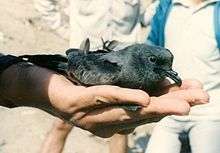
Storm petrels nest colonially, for the most part on islands, although a few species breed on the mainland, particularly Antarctica. Nesting sites are attended at night to avoid predators;[12] the wedge-rumped storm petrels nesting in the Galapagos Islands are the exception to this rule and attend their nesting sites during the day.[13] Storm petrels display high levels of philopatry, returning to their natal colonies to breed. In one instance, a band-rumped storm petrel was caught as an adult 2 m from its natal burrow.[14] Storm petrels nest either in burrows dug into soil or sand, or in small crevices in rocks and scree. Competition for nesting sites is intense in colonies where storm petrels compete with other burrowing petrels, with shearwaters having been recorded killing storm petrels to occupy their burrows.[15] Colonies can be extremely large and dense, with densities as high as 8 pairs/m2 for band-rumped storm petrels in the Galapagos and colonies 3.6 million strong for Leach's storm petrel have been recorded.[16]
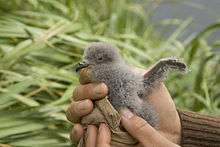
Storm petrels are monogamous and form long-term pair bonds that last a number of years. Studies of paternity using DNA fingerprinting have shown that, unlike many other monogamous birds, infidelity (extra-pair mating) is very rare.[17] As with the other Procellariiformes, a single egg is laid by a pair in a breeding season; if the egg fails, then usually no attempt is made to lay again (although it happens rarely). Both sexes incubate in shifts of up to six days. The egg hatches after 40 or 50 days; the young is brooded continuously for another 7 days or so before being left alone in the nest during the day and fed by regurgitation at night. Meals fed to the chick weigh around 10–20% of the parent's body weight, and consist of both prey items and stomach oil. Stomach oil is an energy-rich (its calorific value is around 9.6 kcal/g) oil created by partly digested prey in a part of the fore gut known as the proventriculus.[18] By partly converting prey items into stomach oil, storm petrels can maximise the amount of energy chicks receive during feeding, an advantage for small seabirds that can only make a single visit to the chick during a 24-hour period (at night).[19] The typical age at which chicks fledge depends on the species, taking between 50 and 70 days. The time taken to hatch and raise the young is long for the bird's size, but is typical of seabirds, which in general are K-selected, living much longer, delaying breeding for longer, and investing more effort into fewer young.[20] The young leave their burrows around 62 days. They are independent almost at once and quickly disperse into the ocean. They return to their original colony after 2 or 3 years, but will not breed until at least 4 years old. Storm petrels have been recorded living as long as 30 years.[21]
Threats and conservation
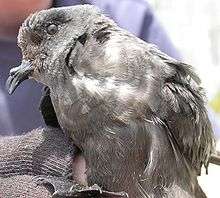
Several species of storm petrel are threatened by human activities.[22] The Guadalupe storm petrel has not been observed since 1906 and most authorities consider it extinct. One species (the ashy storm petrel) is listed as endangered by the IUCN due to a 42% decline over 20 years.[23] For the ringed storm petrel, even the sites of their breeding colonies remain a mystery.
Storm petrels face the same threats as other seabirds; in particular, they are threatened by introduced species. The Guadalupe storm petrel was driven to extinction by feral cats,[24] and introduced predators have also been responsible for declines in other species. Habitat degradation, which limits nesting opportunities, caused by introduced goats and pigs is also a problem, especially if it increases competition from more aggressive burrowing petrels.
Cultural representation of the storm petrel
The name "petrel" is a diminutive form of "Peter", a reference to Saint Peter; it was given to these birds because they sometimes appear to walk across the water's surface. The more specific "storm petrel" or "stormy petrel" is a reference to their habit of hiding in the lee of ships during storms.[25] Early sailors named these birds "Mother Carey's chickens" because they were thought to warn of oncoming storms; this name is based on a corrupted form of Mater Cara, a name for the Blessed Virgin Mary.
Breton folklore holds that storm petrels are the spirits of sea-captains who mistreated their crew, doomed to spend eternity flying over the sea, and they are also held to be the souls of drowned sailors. A sailing superstition holds that the appearance of a storm petrel foretells bad weather.[26] Sinister names from Britain and France include waterwitch, satanite, satanique, and oiseau du diable.[27]
The association of the storm petrel with turbulent weather has led to its use as a metaphor for revolutionary views,[28] the epithet "stormy petrel" being applied by various authors to characters as disparate as a Roman tribune,[29] a Presbyterian minister in the early Carolinas,[30] an Afghan governor,[31] or an Arkansas politician.[32]
The "stormy petrel" appears as the standard English translation of the name of the lead character in "Song of the Stormy Petrel", a 1901 poem by the Russian revolutionary writer Maxim Gorky in which he turned to the imagery of subantarctic avifauna to describe Russian society's attitudes to the coming revolution. This poem was called "the battle anthem of the revolution", and earned Gorky himself the title of the "Storm Petrel of the Revolution".[33][34] While this English translation of the bird's name may not be a very ornithologically accurate translation of the Russian burevestnik (буревестник),[35] it is poetically appropriate, as burevestnik literally means "the announcer of the storm". To honour Gorky and his work, the name Burevestnik was bestowed on a variety of institutions, locations, and products in the USSR.[28]
The motif of the stormy petrel has a long association with revolutionary anarchism. Various groups adopted the bird's name, either as a group identifier, as in the Spanish Civil War,[36] or for their publications. "Stormy Petrel" was the title of a German anarchist paper of the late 19th century; it was also the name of a Russian exile anarchist communist group operating in Switzerland in the early 20th century. The Stormy Petrel (Burevestnik) was the title of the magazine of the Anarchist Communist Federation in Russia around the time of the 1905 revolution,[37] and is still an imprint of the London group of the Anarchist Federation of Britain and Ireland.[38] Writing in 1936, Emma Goldman referred to Buenaventura Durruti as "this stormy petrel of the anarchist and revolutionary movement".
The stormy petrel is also the mascot of Oglethorpe University, a small liberal arts college in Atlanta, Georgia.
Species
| Subfamily | Common name | Scientific name | Status |
|---|---|---|---|
| Hydrobatinae | European storm petrel | Hydrobates pelagicus | extant |
| Leach's storm petrel | Oceanodroma leucorhoa | extant | |
| Townsend's storm petrel | Oceanodroma socorroensis | extant | |
| Ainley's storm petrel | Oceanodroma cheimomnestes | extant | |
| Matsudaira's storm petrel | Oceanodroma matsudairae | extant | |
| Least storm petrel | Oceanodroma microsoma | extant | |
| Wedge-rumped storm petrel | Oceanodroma tethys | extant | |
| Band-rumped storm petrel | Oceanodroma castro | extant | |
| Monteiro's storm petrel | Oceanodroma monteiroi | extant | |
| Swinhoe's storm petrel | Oceanodroma monorhis | extant | |
| Guadalupe storm petrel | Oceanodroma macrodactyla | extinct | |
| Tristram's storm petrel | Oceanodroma tristrami | extant | |
| Markham's storm petrel | Oceanodroma markhami | extant | |
| Black storm petrel | Oceanodroma melania | extant | |
| Ashy storm petrel | Oceanodroma homochroa | extant | |
| Hornby's storm petrel | Oceanodroma hornbyi | extant | |
| Fork-tailed storm petrel | Oceanodroma furcata | extant |
References
- Carboneras, C. (1992) "Family Hydrobatidae (Storm petrels)" pp. 258–265 in Handbook of Birds of the World Vol 1. Barcelona:Lynx Edicions, ISBN 84-87334-10-5
- Nunn, G & Stanley, S. (1998). "Body Size Effects and Rates of Cytochrome b Evolution in Tube-Nosed Seabirds". Molecular Biology and Evolution. 15 (10): 1360–1371. doi:10.1093/oxfordjournals.molbev.a025864. PMID 9787440. Corrigendum
- Harrison, P. (1983) Seabirds, an identification guide Houghton Mifflin Company:Boston, ISBN 0-395-33253-2
- Onley and Scofield, (2007) Albatrosses, Petrels and Shearwaters of the World. Helm, ISBN 978-0-7136-4332-9
- Withers, P.C (1979). "Aerodynamics and Hydrodynamics of the 'Hovering' Flight of Wilson's Storm Petrel". Journal of Experimental Biology. 80: 83–91.
- Pennycuick, C. J. (1982). "The flight of petrels and albatrosses (Procellariiformes), observed in South Georgia and its vicinity". Philosophical Transactions of the Royal Society of London B. 300 (1098): 75–106. doi:10.1098/rstb.1982.0158.
- Brinkley, E. & Humann, A. (2001) "Storm petrels" in The Sibley Guide to Bird Life and Behaviour (Elphick, C., Dunning J. & Sibley D. eds) Alfred A. Knopf:New York ISBN 0-679-45123-4
- Brooke, M. (2004). Albatrosses and Petrels Across the World Oxford University Press, Oxford, UK ISBN 0-19-850125-0
- Harrison N.; Whitehouse M.; Heinemann D.; Prince P.; Hunt G.; Veit R. (1991). "Observations of Multispecies Seabird Flocks around South Georgia" (PDF). Auk. 108 (4): 801–810.
- Van Den, Berg AB; Smeenk, C; Bosman, CAW; Haase, BJM; Van Der, Niet AM; Cadée, GC (1990). "Barau's petrel Pterodroma baraui, Jouanin's petrel Bulweria fallax and other seabirds in the northern Indian Ocean in June–July 1984 and 1985" (PDF). Ardea. 79: 1–14. Archived from the original (PDF) on 2013-01-07. Retrieved 2012-12-20.
- Ainley, D. G., and W. T. Everett. 2001. Black Storm Petrel (Oceanodroma melania). In The Birds of North America, No. 577 (A. Poole and F. Gill, eds.). The Birds of North America, Inc., Philadelphia, PA.
- Bretagnolle, V. (1990). "Effect of moon on activity of petrels (Class Aves) from the Selvagen Islands (Portugal)". Canadian Journal of Zoology. 68 (7): 1404–1409. doi:10.1139/z90-209.
- Ayala L, Sanchez-Scaglioni R (2007). "A new breeding location for Wedge-rumped Storm Petrels (Oceanodroma tethys kelsalli) in Peru". Journal of Field Ornithology. 78 (3): 303–307. doi:10.1111/j.1557-9263.2007.00106.x.
- Harris, M. (1979). "Survival and ages of first breeding of Galapagos seabirds" (PDF). Bird Banding. 50 (1): 56–61. doi:10.2307/4512409. JSTOR 4512409.
- Ramos, J.A.; Monteiro, L.R.; Sola, E.; Moniz, Z. (1997). "Characteristics and competition of nest cavities in burrowing Procellariiformes" (PDF). Condor. 99 (3): 634–641. doi:10.2307/1370475. JSTOR 1370475.
- West, J. & Nilsson, R. (1994). "Habitat use and burrow densities of burrow-nesting seabirds on South East Island, Chatham Islands, New Zealand" (PDF). Notornis (Supplement). 41: 27–37. Archived from the original (PDF) on 2008-11-20.
- Mauwk, T.; Waite, T. & Parker, P. (1995). "Monogamy in Leach's Storm Petrel:DNA-fingerprinting evidence" (PDF). Auk. 112 (2): 473–482. doi:10.2307/4088735. JSTOR 4088735.
- Warham, J. (1976). "The Incidence, Function and ecological significance of petrel stomach oils" (PDF). Proceedings of the New Zealand Ecological Society. 24: 84–93. Archived from the original (PDF) on 2006-07-24.
- Obst, B & Nagy, K (1993). "Stomach Oil and the Energy Budget of Wilson's Storm Petrel Nestlings" (PDF). Condor. 95 (4): 792–805. doi:10.2307/1369418. JSTOR 1369418.
- Schreiber, Elizabeth A. & Burger, Joanne.(2001.) Biology of Marine Birds, Boca Raton:CRC Press, ISBN 0-8493-9882-7
- Klimkiewicz, M. K. 2007. Longevity Records of North American Birds Archived 2011-05-19 at the Wayback Machine. Version 2007.1. Patuxent Wildlife Research Center. Bird Banding Laboratory. Laurel MD.
- IUCN, 2006. Red List: Storm petrel Species Retrieved August 27, 2006.
- Sydeman, W.; Nurr, N.; McLaren, E.; McChesney, G. (1998). "Status and Trends of the Ashy Storm Petrel on Southeast Farallon Island, California, based upon capture-recapture analyses". Condor. 100 (3): 438–447. doi:10.2307/1369709. JSTOR 1369709.
- A contemporary account of the decline of the Guadalupe Storm Petrel – Thayer, J.; Bangs, O (1908). "The Present State of the Ornis of Guadaloupe Island" (PDF). Condor. 10 (3): 101–106. doi:10.2307/1360977. hdl:2027/hvd.32044072250186. JSTOR 1360977.
- Slotterback, J. W. (2002). Band-rumped Storm Petrel (Oceanodroma castro) and Tristram’s Storm-Petrel (Oceanodroma tristrami). In The Birds of North America, No. 673 (A. Poole and F. Gill, eds.). The Birds of North America, Inc., Philadelphia, PA.
- Eyers, Jonathan (2011). Don't Shoot the Albatross!: Nautical Myths and Superstitions. A&C Black, London, UK. ISBN 978-1-4081-3131-2.
- Armstrong, Edward A. (1970) [1958]. The Folklore of Birds. Dover. p. 213. ISBN 0-486-22145-8.
- Ziolkowski, Margaret (1998), Literary Exorcisms of Stalinism: Russian Writers and the Soviet Past, Camden House, p. 111, ISBN 1571131795
- Abbott, Frank Frost (1909), Society and Politics in Ancient Rome: Essays and Sketch, Biblo & Tannen Publishers, p. 113, ISBN 0819601187
- Lynah, Mary-Elizabeth (1934), Archibald Stobo of Carolina: Presbyterianism's Stormy-petrel, American Historical Society
- Grey, C. (1929), Garrett, Herbert Leonard Offley (ed.), European Adventurers of Northern India, 1785 to 1849, Atlantic Publishers & Distri, pp. 186, 190; the person in question is Khaji Khan, Kakar (or Kakur), governor of Bamian
- Jacobson, Charles; Davis, Jeff (1925), The life story of Jeff Davis: the stormy petrel of Arkansas politics, Parke-Harper publishing co.
- "A Legend Exhumed", review of "Stormy Petrel: The Life and Work of Maxim Gorky" by Dan Levin. Appleton-Century. Time Magazine, June 25, 1965
- Mironov (2012) p. 461.
- A 1903 edition of Vladimir Dal's Explanatory Dictionary of the Living Great Russian Language, would define burevestnik (the name of the bird used by Gorky's in Russian) or a "bird of storm" as a generic name for the Procellariidae, and would illustrate it with several examples, including the species known in English as the wandering albatross, southern giant petrel, northern fulmar, and European storm petrel. The actual Russian species name for the European storm petrel, according to the same dictionary, is kachurka, rather than an adjective phrase with burevestnik. See the entry Буря ("storm") in: Толковый словарь живого великорусского языка. В 4 тт. Т. 1: А—3 (Explanatory Dictionary of the Living Great Russian Language, in four volumes. Volume 4, A through Ze (in Cyrillic script) (in Russian). 2001. p. 172. ISBN 5-224-02354-8. (This is a modern reprint (using modernized Russian orthography) of the 1903 edition, which would have been familiar to Gorky and his readers).
- Christie (2005) p. 43.
- Yaroslansky (1937) Introduction.
- "Anarchist pamphlets/booklets". Anarchists Federation. Archived from the original on 2013-05-13. Retrieved 19 September 2013.
External links
| Wikimedia Commons has media related to Hydrobatidae. |
| Wikispecies has information related to Hydrobatidae |
- Storm petrel videos on the Internet Bird Collection